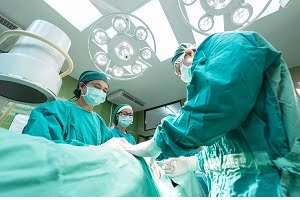Types of Surgery for Salivary Gland Cancer
- Updated on: Jul 15, 2024
- 5 min Read
- Published on Nov 9, 2020

Most salivary gland cancers are benign and do not spread to other body parts, but some salivary gland cancers become cancerous and spread to other body parts and can be lethal. Salivary gland tumors can be cured by surgery. However, few cancers can be treated by chemotherapy and radiation therapy.
Types of Surgery for Salivary Gland Cancer Treatment:
Neck Dissection (Lymph Node Removal)
Lymph nodes are small bean-shaped glands present in the neck and other parts of the body. They are the first organs to be affected when cancer starts spreading from other parts. Neck Dissection or lymph node removal is a surgical process to remove lymph nodes affected by cancer. Removal of lymph nodes not only treats cancer but also helps pathologists examine the nodes and determine future treatments.
During this procedure, an incision is made in the neck for neck dissection. Other important anatomical structures that run through the neck, like blood vessels, are identified and preserved during operation. If the neck dissection is done to treat the primary tumor, then the other body parts’ tumor is also removed from the body. For instance, if the tumor’s primary site is the larynx, then that will also be removed at the time of neck dissection.
There are three major anatomical structures present within the neck which are closely involved in the dissection. During the procedure, the doctors try to protect all these structures, but if they are invaded by cancer, then they need to be also removed. These three important structures include:
- The internal jugular vein which helps the blood to return back to the heart from the head.
- The spinal accessory nerve which controls the movement of the major muscles of the shoulder.
- The sternocleidomastoid muscle that helps in the movement of the neck to the opposite side. It is also the largest and most superficial cervical muscle.
Read About Salivary Gland Cancer
Consequences of Removal of Internal Jugular Vein, Spinal Accessory Nerve, and Sternocleidomastoid Muscle
Removal of the internal jugular vein does not cause problems as such because many other veins can help in the flow of blood back to the heart. Removing one of the internal jugular veins may result in some temporary inflammation, which usually goes away within 2-3 weeks. In situations where dissection is performed at both sides of the neck, there are chances of both internal jugular veins getting removed, resulting in severe inflammation.
Removal of the spinal accessory nerve limits the arm’s movement, making it difficult to move the arm towards the head from a horizontal position. The shoulder might also bend a little, and there may be mild swelling and pain. Physiotherapy after the operation can help in avoiding such problems.
Removal of the sternocleidomastoid muscle does not cause many problems, except the neck might look a little sunken. However, if these muscles are removed from both sides, it will affect head flexing strength.
Types of Neck Dissection
Radical Neck Dissection: In this procedure, the internal jugular vein, sternocleidomastoid muscle, and spinal accessory nerve along with the lymph node of one side are removed.
Selective Neck Dissection: In this procedure, all the lymph nodes are removed that are at high risk of cancer metastasis. Muscle and nerve tissues around lymph nodes are left intact so that the neck can have a proper movement. This is also known as functional neck dissection.
Modified Radical Neck Dissection: Lymph nodes from level I to V are removed, but the internal jugular vein, sternocleidomastoid muscle, and the spinal accessory nerve are kept intact.
Parotidectomy
This type of surgery is done to remove the tumors of parotid glands. The parotid gland has two lobes: the deep lobe and the superficial lobe. The facial nerve separates these two lobes. Two types of parotidectomy can be performed.
Superficial Parotidectomy: It is done to remove the tumors from the superficial lobe. The incision is made from the front of the ear to the neck, followed by the jaw line. The rim of the healthy tissue is also removed without damaging the facial nerve.
Total Parotidectomy: It is done to remove the tumors from the deep lobe or the deep and superficial lobe. The cute made is the same as that made for superficial Parotidectomy.
Monitoring of Facial Nerve
A lot of precision and accuracy is required while performing Parotidectomy. Preservation of the facial nerve, along with the removal of the complete tumor, is the priority. An advanced facial nerve monitoring system is used to monitor facial nerves during the operation process. Sometimes during surgery, the facial nerve loses its functionality and becomes weak either temporarily or permanently. The weakening of the facial nerve is dependent on the size and extent of the parotid gland tumor.
Know About the Complications of Chemotherapy for Head and Neck Cancer
Facial Reanimation (Facial Paralysis Treatment)
The facial nerve might lose its functionality during parotidectomy, causing partial or complete facial paralysis. During facial paralysis, the patient may face problems in basic facial movements like smiling, closing eyes, raising eyebrows, difficulty while eating and sleeping, etc.
For treating facial paralysis, doctors transfer muscles and nerves from other body parts to the face. Another treatment called the dual – babysitter technique can also be performed. In this technique, nerves from the tongue and biting muscle in combination with muscle graft are rewired. These treatments of facial reanimation help people to regain their facial activity within months. The dual – babysitter technique be performed either during the surgery or after few months of the surgery.
You May Want to Read:
In Future, Salivary Glands Can Be Grown in Laboratory
Familial Predisposition For Salivary Gland Cancer
Submandibular or Sublingual Gland Excision
The submandibular or sublingual gland is responsible for 70% of saliva production. It is of walnut-size, predominantly serous, and is one of the paired salivary glands. It is located just below the jaw, and saliva from this gland moves to the mouth via a duct. A tumor is formed in this duct when the duct gets blocked due to small depositions or due to the duct’s narrowing. This blockage restricts the flow of the saliva, causing inflammation and pain. Removal of this gland will not cause many problems because other glands will continue producing saliva.
Before the surgery, the patient needs to tell their doctor if they are taking over-the-counter drugs, herbs, and supplements. In such cases, the doctor will guide the patients about such intakes being safe or not. The surgery takes about 45 minutes. An intravenous drip is administered on the arm or hand to supply fluids and medicines. General anesthesia is given to the patient before the surgery, which keeps the patient unconscious during the whole surgical process.
An incision is made at the upper part of the neck or just below the jaw line. The facial nerve is monitored to avoid any damage. The gland is removed from the body along with the lymph nodes if required. After the operation, local anesthesia is given so that patient could not feel the pain.
FAQs
After the Removal of Salivary Glands, Will the Mouth Feel Dry?
Removal of submandibular gland doesn’t affect saliva production as there are other glands which can produce saliva.
Is Permanent Nerve Damage Possible After the Surgery?
Nerve damage is usually temporary and gets better by the time, but permanent damages may also occur in some critical cases.
How Much Time is Taken in the Removal of Submandibular Gland?
Removal of the submandibular gland usually takes 45 minutes, but it might take a little longer depending upon the severity and difficulty of the tumor.
Which Food Items Should be Avoided After Submandibular Gland Removal?
Hot, spicy, and oily food should be avoided. Soft food like gelatin, ice-cream, egg, pasta, and mashed potatoes can be preferred.











